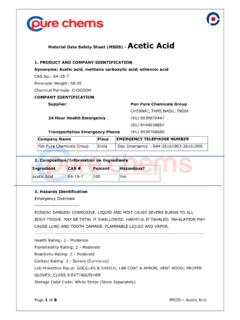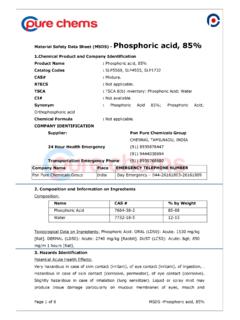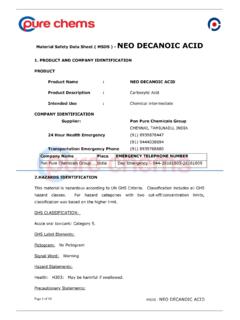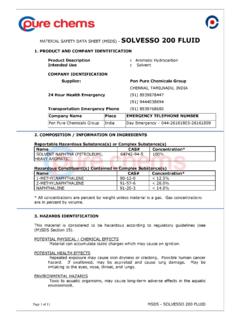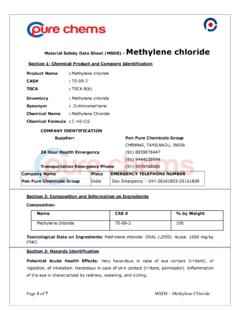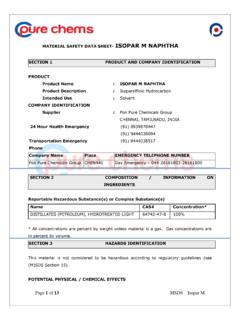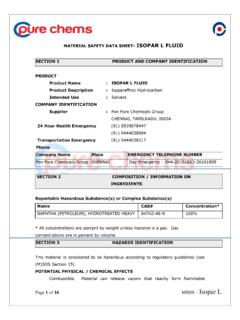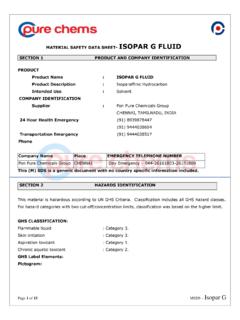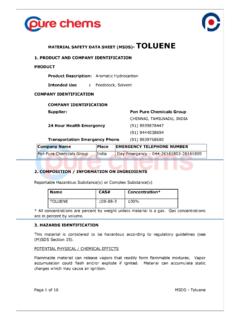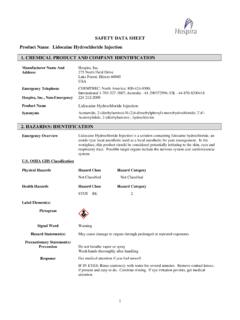Transcription of Sodium chloride - Pure Chemical
1 msds - Sodium chloride Page 1 of 1 material safety data sheet ( msds ) - Sodium chloride 1. Chemical Product and Company Identification Product Name : Sodium chloride Catalog Codes : SLS3262, SLS1045, SLS3889, SLS1669,SLS3091 CAS# : 7647-14-5 RTECS : VZ4725000 TSCA : TSCA 8(b) inventory: Sodium chloride CI# : Not applicable. Synonym : Salt; Sea Salt Chemical Name : Sodium chloride Chemical Formula : NaCl COMPANY IDENTIFICATION Supplier: Pon Pure Chemicals Group CHENNAI, TAMILNADU, INDIA 24 Hour Health Emergency (91) 8939878447 (91) 9444038694 Transportation Emergency Phone (91) 8939768680 Company Name Place EMERGENCY TELEPHONE NUMBER Pon Pure Chemicals Group India Day Emergency 044-26161803-26161809 2. Composition and Information on Ingredients Composition: Name CAS # % by Weight Sodium chloride 7647-14-5 100 Toxicological data on Ingredients : Sodium chloride : ORAL (LD50): Acute: 3000 mg/kg [Rat.]
2 ]. 4000 mg/kg [Mouse]. DERMAL (LD50): Acute: >10000 mg/kg [Rabbit]. DUST (LC50) : Acute: >42000 mg/m 1 hours [Rat]. 3. Hazards Identification Potential Acute Health Effects: Slightly hazardous in case of skin contact (irritant), of eye contact (irritant), of ingestion, of inhalation. Potential Chronic Health Effects: msds - Sodium chloride Page 2 of 2 CARCINOGENIC EFFECTS: Not available. MUTAGENIC EFFECTS: Mutagenic for mammalian somatic cells. Mutagenic for bacteria and/or yeast. TERATOGENIC EFFECTS: Not available. DEVELOPMENTAL TOXICITY: Not available. Repeated or prolonged exposure is not known to aggravate medical condition. 4. First Aid Measures: Eye Contact: Check for and remove any contact lenses. In case of contact, immediately flush eyes with plenty of water for at least 15 minutes.
3 Cold water may be used. Get medical attention. Skin Contact: Wash with soap and water. Cover the irritated skin with an emollient. Get medical attention if irritation develops. Cold water may be used. Serious Skin Contact: Not available. Inhalation: If inhaled, remove to fresh air. If not breathing, give artificial respiration. If breathing is difficult, give oxygen. Get medical attention if symptoms appear. Serious Inhalation: Not available. Ingestion: Do NOT induce vomiting unless directed to do so by medical personnel. Never give anything by mouth to an unconscious person. Loosen tight clothing such as a collar, tie, belt or waistband. Get medical attention if symptoms appear. Serious Ingestion: Not available. 5. Fire and Explosion data Flammability of the Product : Non-flammable.
4 Auto-Ignition Temperature : Not applicable. Flash Points : Not applicable. Flammable Limits : Not applicable. Products of Combustion : Not available. Fire Hazards in Presence of Various Substances: Not applicable. Explosion Hazards in Presence of Various Substances: Risks of explosion of the product in presence of mechanical impact: Not available. Risks of explosion of the product in presence of static discharge : Not available. Fire Fighting Media and Instructions : Not applicable. Special Remarks on Fire Hazards: When heated to decomposition it emits toxic fumes. msds - Sodium chloride Page 3 of 3 Special Remarks on Explosion Hazards: Electrolysis of Sodium chloride in presence of nitrogenous compounds to produce chlorine may lead to formation of explosive nitrogen trichloride.
5 Potentially explosive reaction with dichloromaleic anhydride + urea. Release Measures Small Spill: Use appropriate tools to put the spilled solid in a convenient waste disposal container. Finish cleaning by spreading water on the contaminated surface and dispose of according to local and regional authority requirements. Large Spill: Use a shovel to put the material into a convenient waste disposal container. Finish cleaning by spreading water on the contaminated surface and allow to evacuate through the sanitary system. and Storage Precautions: Keep locked Do not ingest. Do not breathe dust. Avoid contact with eyes. Wear suitable protective clothing. If ingested, seek medical advice immediately and show the container or the label.
6 Keep away from incompatibles such as oxidizing agents, acids. Storage: Keep container tightly closed. Keep container in a cool, well-ventilated area. Hygroscopic. 8. Exposure Controls/Personal Protection Engineering Controls: Use process enclosures, local exhaust ventilation, or other engineering controls to keep airborne levels below recommended exposure limits. If user operations generate dust, fume or mist, use ventilation to keep exposure to airborne contaminants below the exposure limit. Personal Protection: Splash goggles, Lab coat, Dust respirator. Be sure to use an approved/certified respirator or equivalent Gloves. Personal Protection in Case of a Large Spill: Splash goggles, Full suit, Dust respirator, Boots, Gloves.
7 A self contained breathing apparatus should be used to avoid inhalation of the product. Suggested protective clothing might not be sufficient; consult a specialist BEFORE handling this msds - Sodium chloride Page 4 of 4 product. Exposure Limits: Not available. 9. Physical and Chemical Properties Physical state and appearance : Solid. (Solid crystalline powder.) Odor : Slight. Taste : Saline. Molecular Weight : g/mole Color : White. pH (1% soln/water) : 7 [Neutral.] Boiling Point : 1413 C ( F) Melting Point : 801 C ( F) Critical Temperature : Not available. Specific Gravity : (Water = 1) Vapor Pressure : Not applicable. Vapor Density : Not available. Volatility : Not available. Odor Threshold : Not available. Water/Oil Dist.
8 Coeff. : Not available. Ionicity (in Water) : Not available. Dispersion Properties : See solubility in water. Solubility: Easily soluble in cold water, hot water. Soluble in glycerol, and ammonia. Very slightly soluble in alcohol. Insoluble in Hydrochloric Acid. 10. Stability and Reactivity data Stability : The product is stable. Instability Temperature : Not available. Conditions of Instability : Incompatible materials, high temperatures. Incompatibility with various substances : Reactive with oxidizing agents, metals, acids. Corrosivity : Not considered to be corrosive for metals and glass. Special Remarks on Reactivity: Hygroscopic reacts with most non-noble metals such as iron or steel, building materials (such as cement) Sodium chloride is rapidly attacked by bromine trifluoride, Violent reaction with lithium.
9 msds - Sodium chloride Page 5 of 5 Special Remarks on Corrosivity : Not available. Polymerization : Will not occur. 11. Toxicological Information Routes of Entry: Inhalation. Ingestion. Toxicity to Animals: WARNING : THE LC50 VALUES HEREUNDER ARE ESTIMATED ON THE BASIS OF A 4-HOUR EXPOSURE. Acute oral toxicity (LD50) : 3000 mg/kg [Rat.]. Acute dermal toxicity (LD50) : >10000 mg/kg [Rabbit]. Acute toxicity of the dust (LC50) : >42000 mg/m3 1 hours [Rat]. Chronic Effects on Humans: MUTAGENIC EFFECTS : Mutagenic for mammalian somatic cells. Mutagenic for bacteria and/ or yeast. Other Toxic Effects on Humans : Slightly hazardous in case of skin contact (irritant), of ingestion, of inhalation. Special Remarks on Toxicity to Animals: Lowest Published Lethal Dose (LDL) [Man] - Route: Oral; Dose: 1000 mg/kg Special Remarks on Chronic Effects on Humans: Causes adverse reproductive effects in humans (fetotoxicity, abortion) by intraplacental route.
10 High intake of Sodium chloride , whether from occupational exposure or in the diet, may increase risk of TOXEMIA OF PREGNANCY in susceptible women (Bishop, 1978). Hypertonic Sodium chloride solutions have been used to induce abortion in late pregnancy by direct infusion into the uterus (Brown et al, 1972), but this route of administration is not relevant to occupational exposures. May cause adverse reproductive effects and birth defects in animals, particularly rats and mice (fetotoxicity, abortion, musculoskeletal abnormalities, and maternal effects (effects on ovaries, fallopian tubes) by oral, intraperitoneal, intraplacental, intrauterine, parenteral, and subcutaneous routes. While Sodium chloride has been used as a negative control n some reproductive studies, it has also been used as an example that almost any Chemical can cause birth defects in experimental animals if studied under the right conditions (Nishimura & Miyamoto, 1969).)
